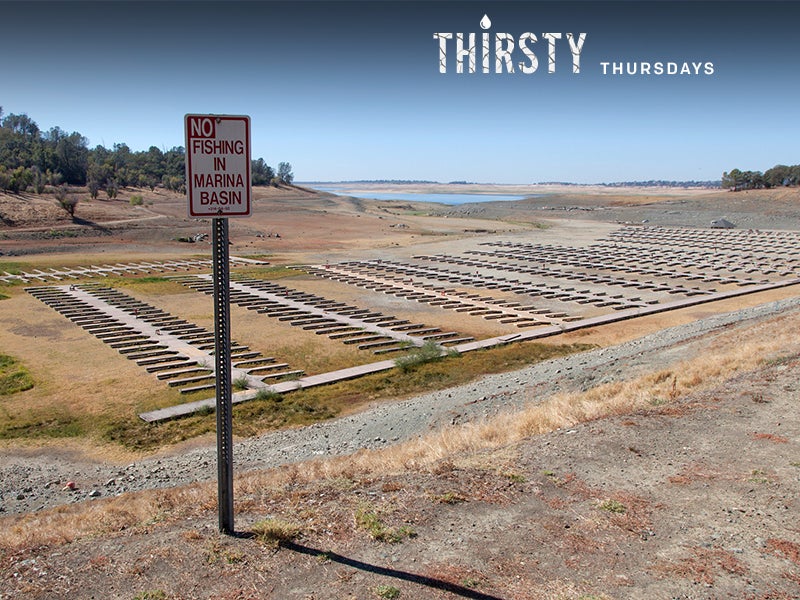California’s Drive for Deeper Water Leaves State on Shaky Ground
As water supplies dry up, groundwater drilling is leading to collapsed bridges, cracked irrigation canals and pipes, and twisted roads and railways. In some places, the ground is sinking nearly one foot a year.

This page was published 10 years ago. Find the latest on Earthjustice’s work.
On June 1, mandatory water restrictions went into effect across California in an attempt to conserve the state’s drought-ravaged water supply. Governor Jerry Brown’s executive order requires cities and towns to reduce water consumption by 25 percent, largely ignoring agriculture, which accounts for about 80 percent of the state’s water use.
Cutbacks will undoubtedly help save water during this crisis, but restrictions on groundwater drilling are conspicuously absent from the governor’s mandate. It’s a problem that leaves the state with a sinking feeling—literally. According to recent reports, the state is collapsing in on itself like an over-ripe peach shriveling in the summer sun, and groundwater depletion is to blame.
Known as land subsidence, the buckling is leading to collapsed bridges, cracked irrigation canals and pipes and twisted roads and railways. In some places, the ground is sinking nearly one foot a year. In addition to infrastructure damage, subsidence is increasing flood risk in some areas as levees and canals sink, too.
Since surface water supplies are increasingly limited, farmers and cities are tapping underground aquifers in the state’s agricultural Central Valley to help make up the difference. Pumping groundwater isn’t a new practice—it’s been going on for the better part of a century. But the pace of extraction has rapidly increased since 2000, depleting water levels far faster than they are naturally replenished. Drilling companies are searching for water deeper and deeper, forced to bore holes 1,000 to 2,000 feet into the earth.
At this point, we‘re pulling from water supplies that date back 20,000 years to the last ice age, and it’s completely unsustainable. Eighty percent of California residents use groundwater to some degree, and some cities and farms entirely depend on it. More than a million acres of cropland may turn to dust as the state’s underground (and largest) reservoir disappears. The irony of a rainy-day fund gone dry is not lost on politicians, environmentalists and farmers.
Groundwater drilling is also causing problems beyond California. The journal Groundwater recently reported that Americans depleted 1,000 cubic kilometers of water across the country between 1900 and 2008. That’s 1014 gallons, or about twice the volume of Lake Erie, the 13th largest lake in the world.
Unlike water above ground, reserves below the surface have remained largely unmonitored. In September 2014, California passed its first ever groundwater regulations. However, local land planners have until 2017 to establish groundwater sustainability agencies, and those agencies have until at least 2020 to create sustainability plans. How long will it take for those sustainability plans to kick in? Twenty-five long, hot years. In the meantime, the more than 100,000 wells boring into the Central Valley’s floor will continue to pump, most without oversight.
Water drilling isn’t the only drilling in the Central Valley—oil and gas exploration is also rampant. Like groundwater pumping, regulation of this type of drilling has also been incredibly lax. In the process of hydraulic fracturing, or “fracking,” companies force huge amounts of water laced with chemicals into the ground to release trapped stores of oil. The fracking water must be disposed of, and ongoing investigations show that wastewater is injected directly into underground aquifers that are supposed to be off-limits.
Last month, Earthjustice filed a motion for a preliminary injunction against California’s Division of Oil, Gas and Geothermal Resources on behalf of the Center for Biological Diversity and the Sierra Club. The injunction would stop the daily unlawful injection of millions of gallons of oil wastewater into California’s protected (and shrinking) underground water supplies.
Stay tuned for updates on this case and other drought news in the next installment of Thirsty Thursdays.
About this serries
Thirsty Thursdays is a biweekly blog series exploring the historic drought in the western United States. In the ongoing series, we’ll share expert opinions, breaking news, compelling articles and the work Earthjustice is doing to protect water resources in a time of extreme water scarcity.
Don’t miss last week’s “Drought News Roundup.”